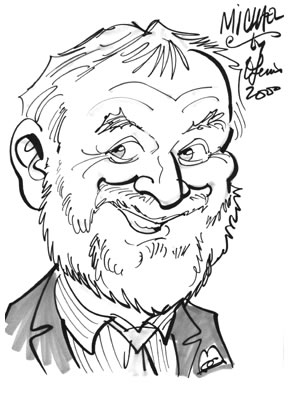profiles - a light-hearted look at industry personalities
No. 4 in a continuing series

Caricatures by

Michael Hall
Consultant and former managing director of Roscolab
Michael Hall has had a lifelong fixation with the technical ephemera associated with showbiz. He claims, with a glint in his eye, that it is all part of a serious study and love of the performing arts and of things within it that have been painted, projected, move, flutter or change colour or have smoke pouring out of them.
One of his earliest memories was being impressed for some reason by the hoarding for Gone With the Wind that was left bravely dangling amongst the bombed remains of his home town cinema at Rye in Sussex in 1942. He then remembers his first on-stage performance as a page boy to Hamlet's Queen at the Canterbury Garrison Theatre in 1946 where he was also transfixed, so he tells us, by the three-colour transition from dark blue through sunrise in 30 seconds.
In school physics he remembers being taught that "light comes with heat, but one day scientists will produce cold light". However, although he's been on a quiet and continuing search for suitably quirky scientists with an innate love of the theatre, he is now much more cynical about the whole idea, and says "try a Congo Blue filter in a hot cyc light and dream on!"
As a trainee RAF radar technician in Wiltshire he had no idea that John Watt and Peter Edwards (Rosco Canada) were also training close by, but as far as the safety of local theatres, and possibly local ladies, was concerned, it was perhaps just as well.
While travelling with his team on a radar truck between Berlin and the West, Russian Mig fighters buzzed them, and entertainment suddenly beckoned as safer than operations, although war still loomed. As assistant cinema projectionist for war films he de-focused when the enemy was in a winning sequence and his German colleague turned the sound up. "Hamburg Frost would have been simpler!"
In 1955, following his National Service, Michael moved into lighting - not by design - as a management trainee. Having said he was bored he was promptly transferred to a lighting factory where the colour chemist had had a breakdown and wouldn't tell anyone his colour formulae which kept the company going.
Ten years later he was enjoying serious corporate life as a senior lighting engineer for Osram GEC. While teaching ‘Lighting and Colour for Architects' at the Mayfair Theatre in London his model came on at the totally wrong cue. He quickly realised that the audience found her much interesting and that production values beckoned more than front of house.
In 1975, while researching studio lamp design in Hollywood, he came across Rosco, and after dinner at The Ivy in London with Stan Miller started Roscolab on the South Bank within a derelict building facing London Weekend Television. As a one-person company, he hired a friend to help at Film 77. It was destined to become the most expensive exhibition ever because he later married Val, the lady concerned.
Rosco was essentially fun and about interpreting designers' needs and a far cry from colorimetry: David Hersey's "I want a better Steel Blue 17, that stays clean on check" or how to change beam shape and even bend it round corners.
After 22 years at Rosco he has (almost) retired. He has, on occasion, been spotted in the long distance on Romney Marsh checking the colours on migrating birds with the help of his limited edition Rose 45 bins. And when the curtains are drawn at his Kentish barn, the subtle hint of flicker is not Michael measuring the candlepower - he's busy polishing his collection of magic lanterns, hoping for some moving light action from the projection end.
Look out for the next subject in our Profile series...
view other profiles
© 1999 - 2025 Entertainment Technology Press Limited News Stories







